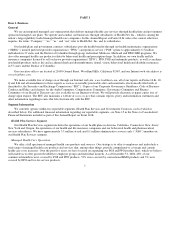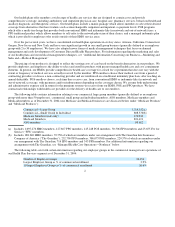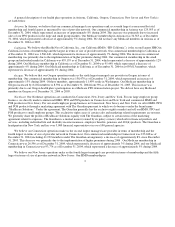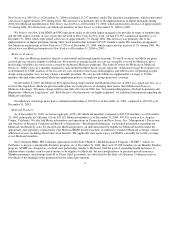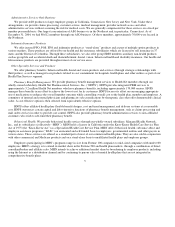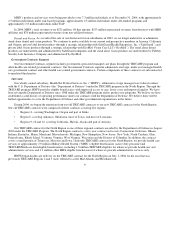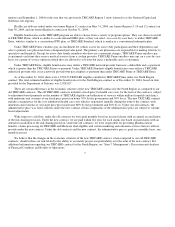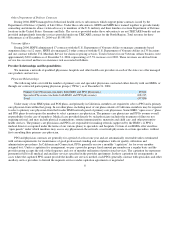Health Net 2004 Annual Report Download - page 12
Download and view the complete annual report
Please find page 12 of the 2004 Health Net annual report below. You can navigate through the pages in the report by either clicking on the pages listed below, or by using the keyword search tool below to find specific information within the annual report.
fee schedules with specialists. Outside of California and Connecticut, most of our HMOs reimburse physicians according to a
discounted fee-for-service schedule, although several have capitation arrangements with certain providers and provider groups in their
market areas.
Our Connecticut HMO has a capitation contract with the Connecticut State Medical Society IPA (“CSMS”). However, all
administration, referral authorization and claims administration is performed by our Connecticut health plan. Physicians are paid on a
fee-for-service basis and reinsurance is provided by Health Net Services (Bermuda), Ltd., a wholly-owned subsidiary of the
Company, to the IPA if claims exceed a specified aggregate limit, which means we effectively assume all risk for costs exceeding the
capitation payment. We are in the process of renegotiating our contract with CSMS to eliminate the capitation arrangement and, as
such, the need for reinsurance. We currently expect to finalize the new contract with CSMS on or prior to the end of the first quarter
of 2005.
The inability of provider groups to properly manage costs under capitation arrangements can result in their financial instability
and the termination of their relationship with us. A provider group’s financial instability or failure to pay secondary providers for
services rendered could lead secondary providers to demand payment from us, even though we have made our regular capitated
payments to the provider group. Depending on state law, we could be liable for such claims.
For services provided under our PPO and POS products, we ordinarily reimburse physicians pursuant to discounted fee-for-
service arrangements.
Hospital Relationships
Our health plan subsidiaries arrange for hospital care primarily through contracts with selected hospitals in their service areas.
These hospital contracts generally have multi-year terms or annual terms with automatic renewals and provide for payments on a
variety of bases, including capitation, per diem rates, case rates and discounted fee-for-service schedules.
Covered inpatient hospital care for our HMO members is comprehensive. It includes the services of hospital-based physicians,
nurses and other hospital personnel, room and board, intensive care, laboratory and x-ray services, diagnostic imaging and generally
all other services normally provided by acute-care hospitals. HMO or PPG nurses and medical directors are actively involved in
discharge planning and case management, which often involves the coordination of community support services, including visiting
nurses, physical therapy, durable medical equipment and home intravenous therapy.
In late 2001, we began to see a pronounced increase in the number of high dollar, stop-loss inpatient claims we were receiving
from hospitals. This increase was caused by some hospitals, primarily in California, aggressively raising chargemasters and billing for
items separately when we believed they should have been included in the base charge. We responded to this trend by instituting a
number of practices designed to reduce the cost of these claims, including, but not limited to, line item review of itemized billing
statements and review of, and adjustment to, the level of prices charged on stop-loss claims.
By early 2004 we began to see evidence that our claims review practices were causing significant friction with hospitals. In the
fourth quarter of 2004, management decided to enter into negotiations to settle a large number of provider disputes in our California
and Northeast health plans, a majority of which related to alleged underpayment of stop-loss claims. As a result of management’s
decision to settle these provider disputes, we recorded a $169 million pre-tax charge in the fourth quarter of 2004 for expenses
associated with provider settlements that have been, or are currently in the process of being, resolved. We are now in the process of
renegotiating our contracts with our California hospitals to provide for, among other things, a fixed reimbursement structure for
reimbursement of inpatient costs, including methodologies such as diagnostic-related groupings, higher stop-loss thresholds and not-
to-exceed provisions. For additional information regarding provider disputes and the fourth quarter 2004 earnings charge, see “Item 3.
Legal Proceedings—Provider Disputes” and “Management’s Discussion and Analysis of Financial Condition and Results of
Operations.”
9




